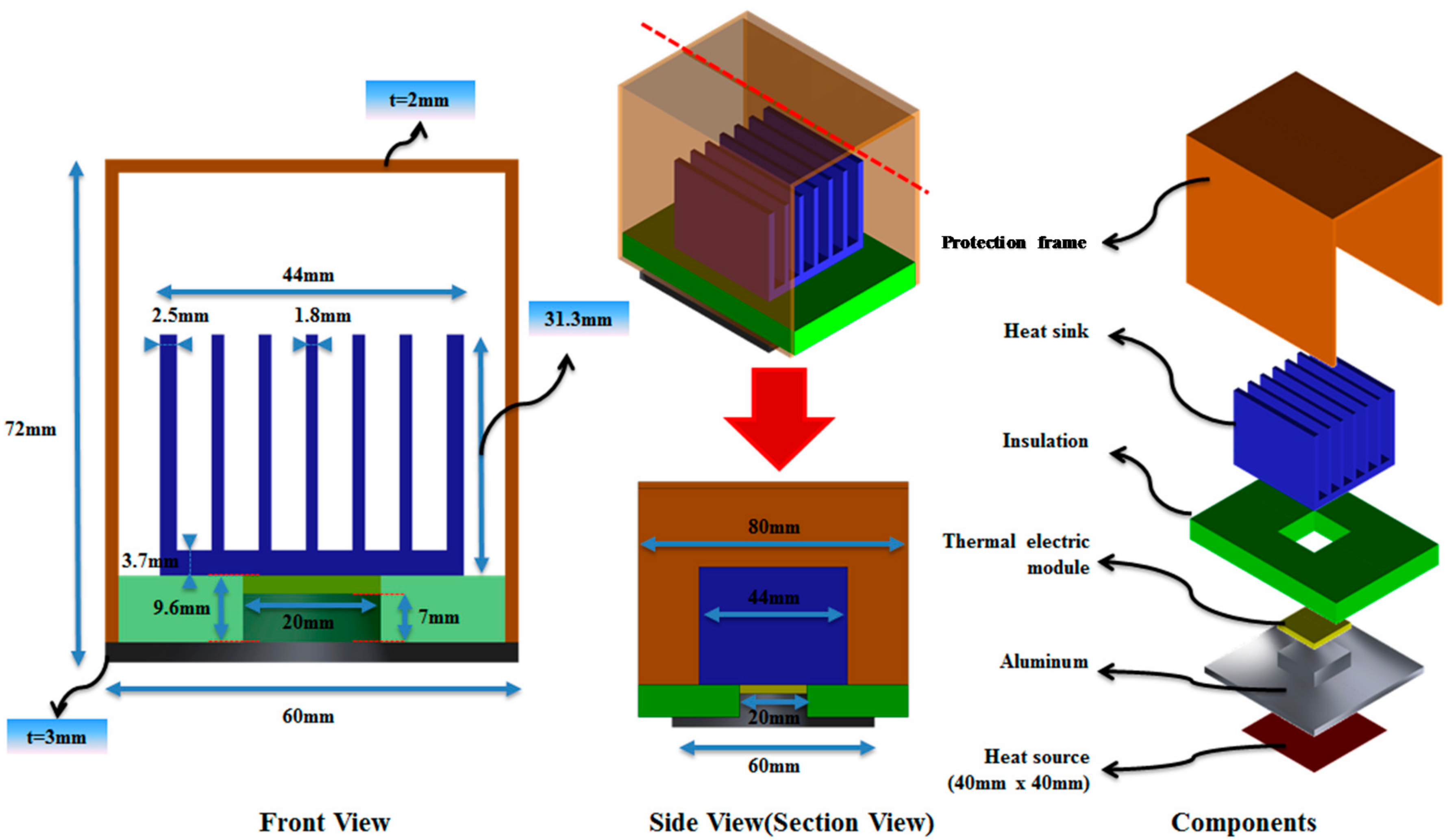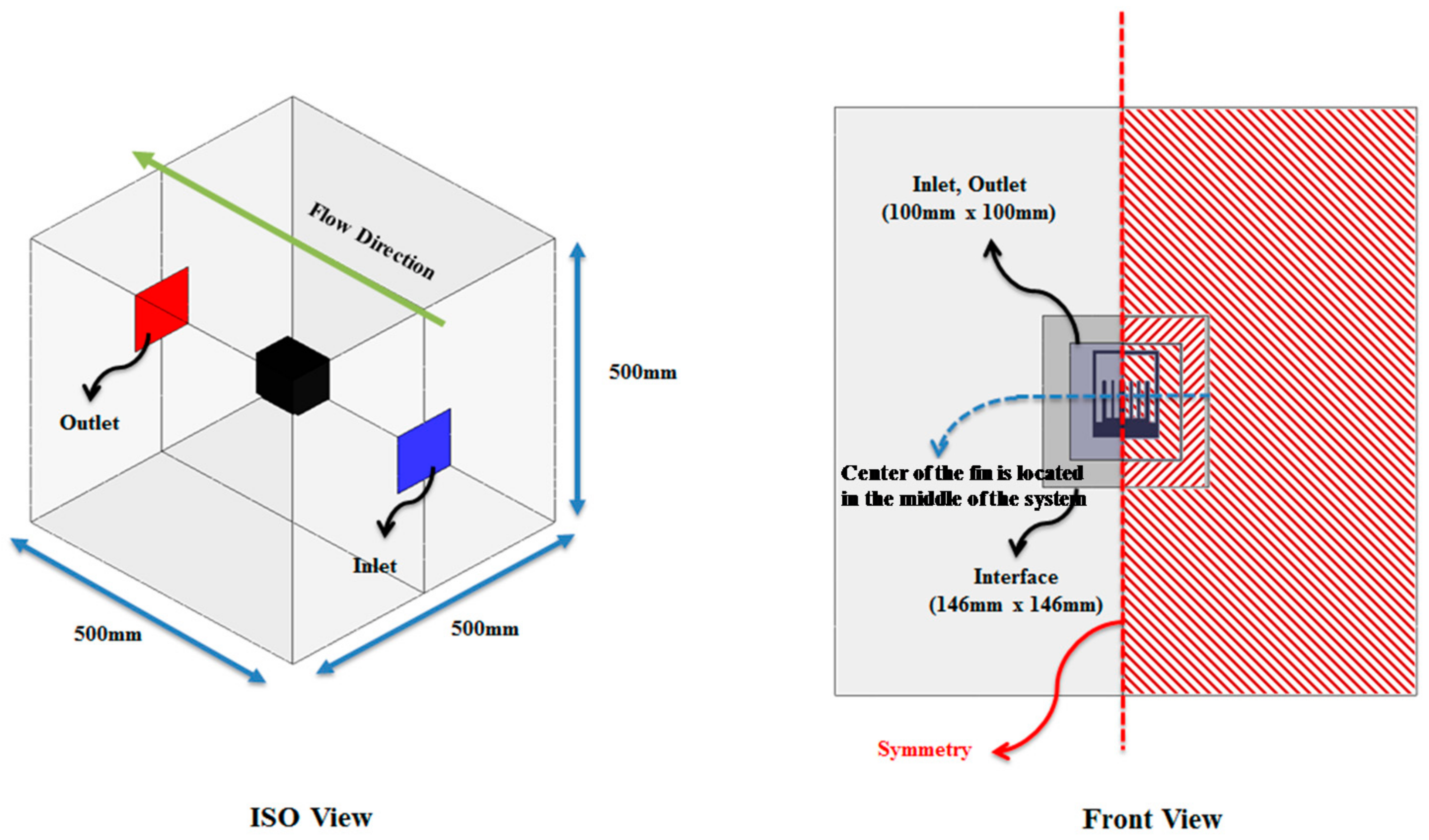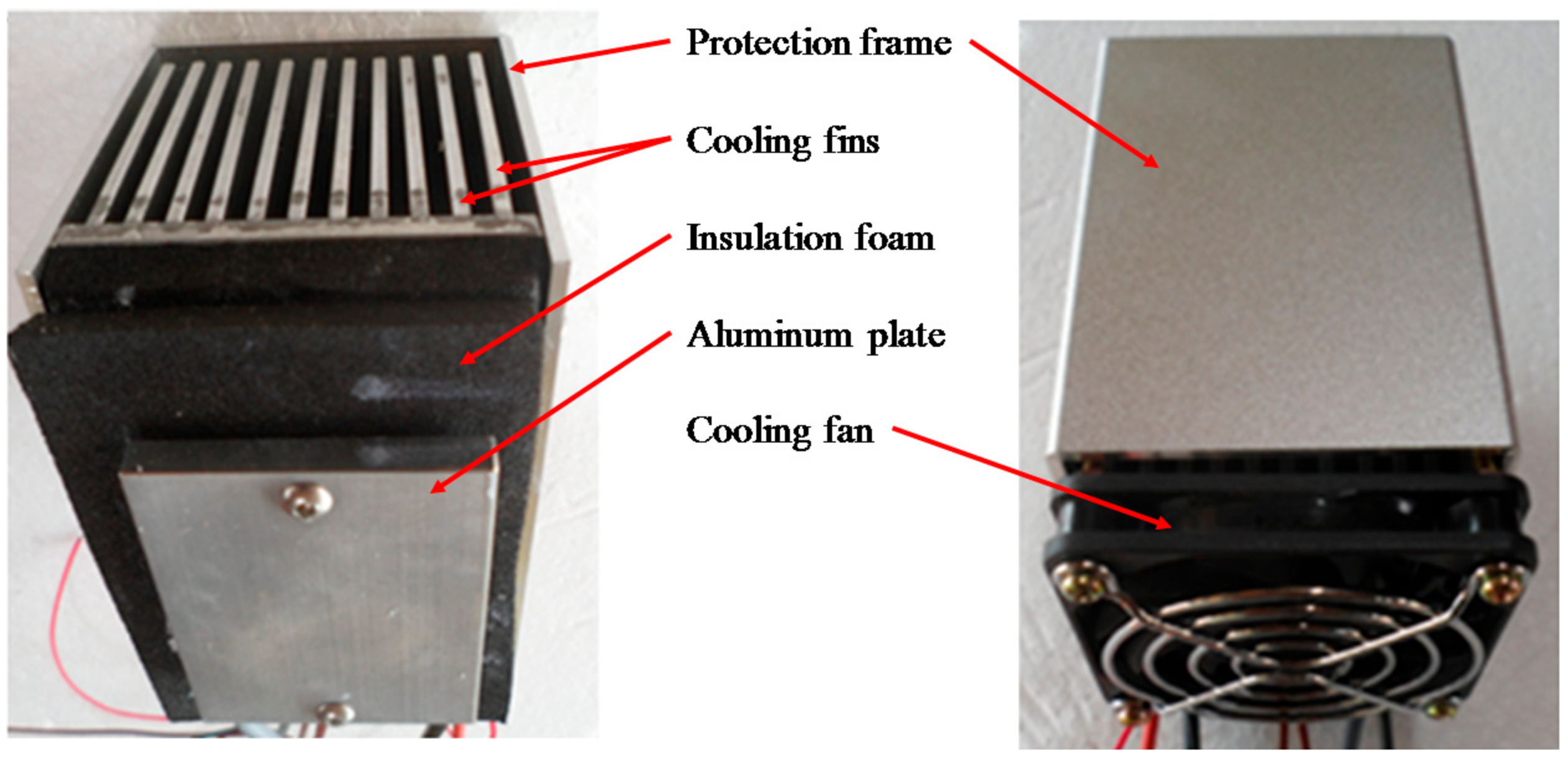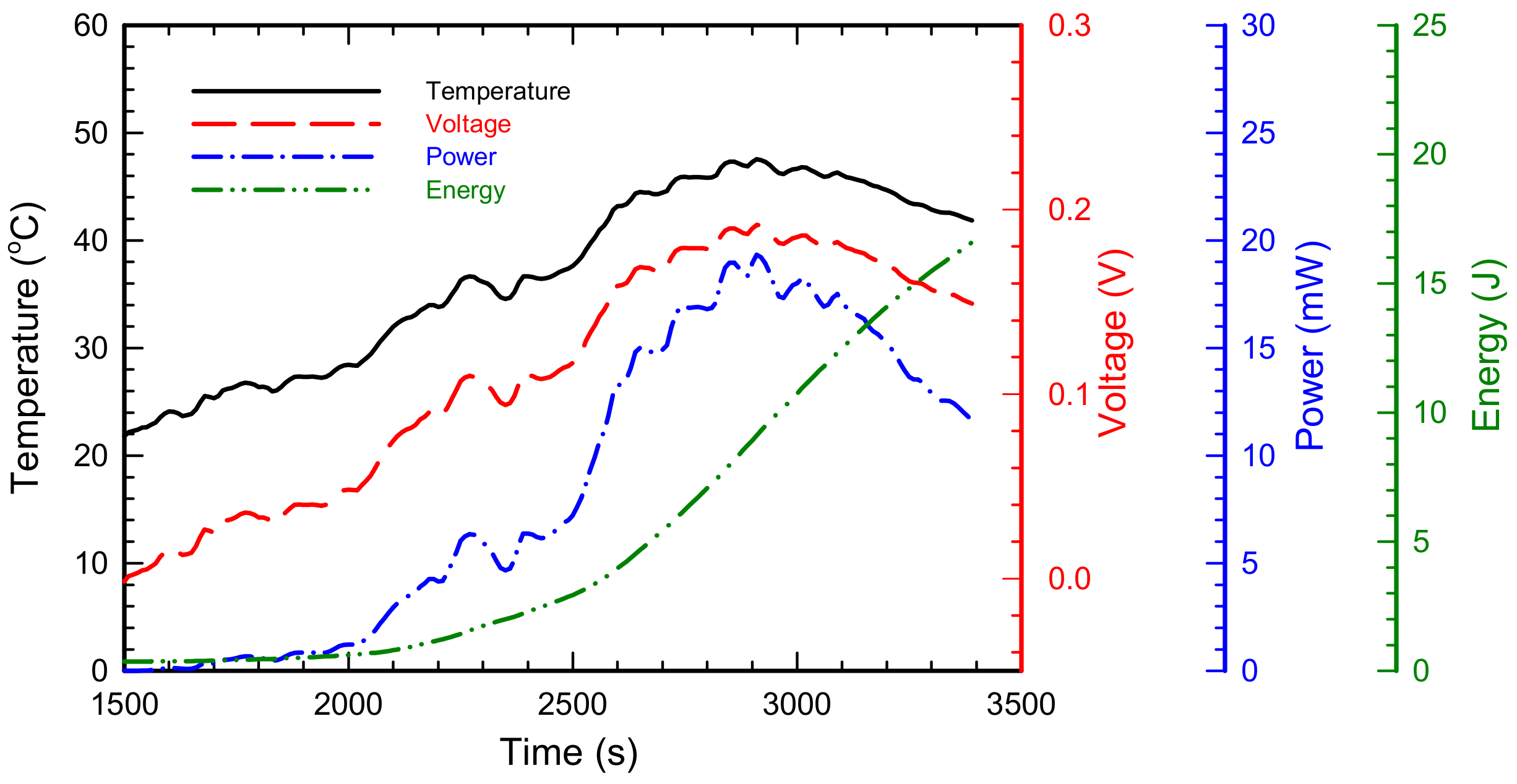Performance Evaluation of Thermoelectric Energy Harvesting System on Operating Rolling Stock
Abstract
:1. Introduction
2. System Design
2.1. Thermoelectric Module
2.2. Cooling System
3. Performance Test on TEMs
4. Results and Discussion
5. Conclusions
Author Contributions
Acknowledgments
Conflicts of Interest
References
- Garcia Marquez, F.P.; Schmid, F.; Collado, J.C. A reliability centered approach to remote condition monitoring. A railway points case study. Reliab. Eng. Syst. Saf. 2003, 80, 33–40. [Google Scholar] [CrossRef]
- Kim, J. Infrared thermographic monitoring for failure characterization in railway axle materials. J. Korean Soc. Nondestr. Test. 2010, 30, 116–120. [Google Scholar]
- Han, S.; Cho, S. Review of non-destructive evaluation technologies for rail inspection. J. Korean Soc. Nondestr. Test. 2011, 31, 398–413. [Google Scholar]
- Choi, K.; Kim, J. A study for applying thermoelectric module in a bogie axle bearing. Trans. Korean Soc. Mech. Eng. B 2016, 40, 255–262. [Google Scholar] [CrossRef]
- Koo, J.S.; Oh, H.S. A new derailment coefficient considering dynamic and geometrical effects of a single wheelset. J. Mech. Sci. Technol. 2014, 28, 3483–3498. [Google Scholar] [CrossRef]
- Choi, S.; Kim, Y.H.; Lee, T.S. Case study on the incident caused by axle bearings of the railway vehicles. In Proceedings of the Korean Society for Railway Fall Conference, Jeju Island, Korea, 30–31 October 2014; Volume 10, pp. 1035–1040. [Google Scholar]
- Choi, S.; Kim, M. A study on efficient rolling stock HBD monitoring method using EWMA technique. J. Korea Acad. Industr. Coop. Soc. 2017, 18, 609–617. [Google Scholar] [CrossRef]
- Bhatia, D.; Lee, J.; Hwang, H.J.; Baik, J.M.; Kim, S.; Choi, D. Design of mechanical frequency regulator for predictable uniform power from triboelectric nanogenerators. Adv. Energy Mater. 2018, 8, 1702667. [Google Scholar] [CrossRef]
- Zhao, X.; Wei, G.; Li, X.; Qin, Y.; Xu, D.; Tang, W.; Yin, H.; Wei, X.; Jia, L. Self-powered triboelectric nano vibration accelerometer based wireless sensor system for railway state health monitoring. Nano Energy 2017, 34, 549–555. [Google Scholar] [CrossRef]
- Choi, W.; Choi, K.; Yang, G.; Kim, J.C.; Yu, C. Improving piezoelectric performance of lead-free polymer composites with high aspect ratio BaTiO3 nanowires. Polym. Test. 2016, 53, 143–148. [Google Scholar] [CrossRef]
- Choi, K.; Choi, W.; Yu, C.; Park, Y.T. Enhanced piezoelectric behavior of PVDF nanocomposite by AC dielectrophoresis alignment of ZnO nanowires. J. Nanomater. 2017, 2017, 6590121. [Google Scholar] [CrossRef]
- Choi, K.; Ahn, D.; Boo, J.H. Influence of temperature gradient induced by concentrated solar thermal energy on the power generation performance of a thermoelectric module. J. Korea Acad. Ind. Coop. Soc. 2017, 18, 777–784. [Google Scholar] [CrossRef]
- Tianchen, Y.; Jian, Y.; Ruigang, S.; Xiaowe, L. Vibration energy harvesting system for railroad safety based on running vehicles. Smart Mater. Struct. 2014, 23, 125046. [Google Scholar] [CrossRef]
- Cahill, P.; Nuallain, N.A.N.; Jackson, N.; Mathewson, A.; Karoumi, R.; Pakrashi, V. Energy harvesting from train-induced response in bridges. J. Bridge Eng. 2014, 19, 04014034. [Google Scholar] [CrossRef]
- Chu, S.; Majumdar, A. Opportunities and challenges for a sustainable energy future. Nature 2012, 488, 294–303. [Google Scholar] [CrossRef] [PubMed]
- Chen, J.; Huang, Y.; Zhang, N.; Zou, H.; Liu, R.; Tao, C.; Fan, X.; Wang, Z.L. Micro-cable structured textile for simultaneously harvesting solar and mechanical energy. Nat. Energy 2016, 1, 16138. [Google Scholar] [CrossRef]
- Chen, J.; Wang, J.L. Reviving vibration energy harvesting and self-powered sensing by a triboelectric nanogenerator. Joule 2017, 1, 480–521. [Google Scholar] [CrossRef]
- Turner, J.A. A realizable renewable energy future. Science 1999, 285, 687–689. [Google Scholar] [CrossRef] [PubMed]
- Bell, L.E. Cooling, heatng, generating power, and recovering waste heat with thermoelectric systems. Science 2008, 321, 1457–1461. [Google Scholar] [CrossRef] [PubMed]
- Jacobson, M.Z. Review of solutions to global warming, air pollution, and energy security. Energy Environ. Sci. 2009, 2, 148–173. [Google Scholar] [CrossRef] [Green Version]
- Wang, Z.L.; Chen, J.; Lin, L. Progress in triboelectric nanogenerators as a new energy technology and self-powered sensors. Energy Environ. Sci. 2015, 8, 2250–2282. [Google Scholar] [CrossRef]
- Wang, E.H.; Zhang, H.G.; Fan, B.Y.; Ouyang, M.G.; Zhao, Y.; Mu, Q.H. Study of working fluid selection of organic Rankine cycle (ORC) for engine waste heat recovery. Energy 2011, 36, 3406–3418. [Google Scholar] [CrossRef] [Green Version]
- Lin, Z.; Chen, J.; Yang, J. Recent progress in triboelectric nanogenerators as a renewable and sustainable power source. J. Nanomater. 2016, 2016, 5651613. [Google Scholar] [CrossRef]
- Huang, K.D.; Tzeng, S. Development of a hybrid pneumatic-power vehicle. Appl. Energy 2005, 8, 47–59. [Google Scholar] [CrossRef]
- Nas, B.; Berktay, A. Energy potential of biodiesel generated from waste cooking oil: An environmental approach. Energy Sources Part B 2007, 2, 63–71. [Google Scholar] [CrossRef]
- Zhu, G.; Chen, J.; Zhang, T.; Jing, Q.; Wang, Z.L. Radial-arrayed rotary electrification for high performance triboelectric generator. Nat. Commun. 2014, 5, 3426. [Google Scholar] [CrossRef] [PubMed] [Green Version]
- Chen, J.; Zhu, G.; Yang, W.; Jing, Q.; Bai, P.; Yang, Y.; Hou, T.C.; Wang, Z.L. Harmonic-resonator-based triboelectric nanogenerator as a sustainable power source and a self-powered active vibration sensor. Adv. Mater. 2013, 25, 6094–6099. [Google Scholar] [CrossRef] [PubMed]
- Zhang, B.; Chen, J.; Jin, L.; Deng, W.; Zhang, L.; Zhang, H.; Zhu, M.; Yang, W.; Wang, J.L. Rotating-disk-based hybridized electromagnetic–triboelectric nanogenerator for sustainably powering wireless traffic volume sensors. ACS Nano 2016, 10, 6241–6247. [Google Scholar] [CrossRef] [PubMed]
- Chen, J.; Yang, J.; Guo, H.; Li, Z.; Zheng, L.; Su, Y.; Wen, Z.; Fan, X.; Wang, Z.L. Automatic Mode Transition Enabled Robust Triboelectric Nanogenerators. ACS Nano 2015, 9, 12334–12343. [Google Scholar] [CrossRef] [PubMed]
- Yang, J.; Chen, J.; Yang, Y.; Zhang, H.; Yang, W.; Bai, P.; Su, Y.; Wang, Z.L. Broadband vibrational energy harvesting based on a triboelectric nanogenerator. Adv. Energy Mater. 2014, 4, 1301322. [Google Scholar] [CrossRef]
- Zhang, N.; Tao, C.; Fan, X.; Chen, J. Progress in triboelectric nanogenerator as self-powered smart sensors. J. Mater. Res. 2017, 32, 1628–1646. [Google Scholar] [CrossRef]
- Armaroli, N.; Balzani, V. The future of energy supply: Challenges and opportunities. Angew. Chem. 2006, 46, 52–66. [Google Scholar] [CrossRef] [PubMed]
- Chen, G.; Dresselhaus, M.S.; Dresselhaus, G.; Fleurial, J.P.; Caillat, T. Recent developments in thermoelectric materials. Int. Mater. Rev. 2003, 48, 45–66. [Google Scholar] [CrossRef]
- Tritt, T.M.; Boettner, H.; Chen, L. Thermoelectris: Direct solar thermal energy conversion. MRS Bull. 2008, 33, 366–368. [Google Scholar] [CrossRef]
- Majumdar, A. Thermoelectricity in Semiconductor nanostructures. Science 2004, 303, 777–778. [Google Scholar] [CrossRef] [PubMed]
- Incropera, F.P. Convection Heat Transfer in Electronic Equipment Cooling. J. Heat Transfer 1988, 110, 1097–1111. [Google Scholar] [CrossRef]
- Tan, Y.K.; Panda, S.K. Optimized wind energy harvesting system using resistance emulator and active rectifier for wireless sensor nodes. IEEE T. Power Electr. 2011, 26, 38–50. [Google Scholar] [CrossRef]












| Number of Fin | Height of Fin (mm) | |||||
|---|---|---|---|---|---|---|
| 31.3 | 35.3 | 39.3 | 43.3 | 47.3 | 51.3 | |
| 7 | 14.89 | 15.66 | 16.34 | 16.94 | 17.49 | 17.97 |
| 9 | 16.12 | 16.93 | 17.64 | 18.25 | 18.81 | 19.32 |
| 11 | 16.81 | 17.65 | 18.39 | 19.01 | 19.57 | 20.05 |
| (a) | ||||
| ΔT (°C) | I at Pmax (mA) | V at Pmax (V) | R at Pmax (Ω) | Pmax (mW) |
| 10 | 47.85 | 0.061 | 1.278 | 2.946 |
| 15 | 68.09 | 0.096 | 1.406 | 6.503 |
| 20 | 89.98 | 0.126 | 1.403 | 11.382 |
| 25 | 112.21 | 0.157 | 1.401 | 17.658 |
| 30 | 127.30 | 0.194 | 1.524 | 24.673 |
| (b) | ||||
| ΔT (°C) | I at Pmax (mA) | V at Pmax (V) | R at Pmax (Ω) | Pmax (mW) |
| 10 | 41.40 | 0.078 | 1.892 | 3.296 |
| 15 | 62.02 | 0.118 | 1.900 | 7.295 |
| 20 | 75.14 | 0.165 | 2.197 | 12.701 |
| 25 | 100.42 | 0.201 | 2.001 | 19.879 |
| 30 | 111.83 | 0.246 | 2.197 | 27.969 |
© 2018 by the authors. Licensee MDPI, Basel, Switzerland. This article is an open access article distributed under the terms and conditions of the Creative Commons Attribution (CC BY) license (http://creativecommons.org/licenses/by/4.0/).
Share and Cite
Ahn, D.; Choi, K. Performance Evaluation of Thermoelectric Energy Harvesting System on Operating Rolling Stock. Micromachines 2018, 9, 359. https://doi.org/10.3390/mi9070359
Ahn D, Choi K. Performance Evaluation of Thermoelectric Energy Harvesting System on Operating Rolling Stock. Micromachines. 2018; 9(7):359. https://doi.org/10.3390/mi9070359
Chicago/Turabian StyleAhn, Dahoon, and Kyungwho Choi. 2018. "Performance Evaluation of Thermoelectric Energy Harvesting System on Operating Rolling Stock" Micromachines 9, no. 7: 359. https://doi.org/10.3390/mi9070359






